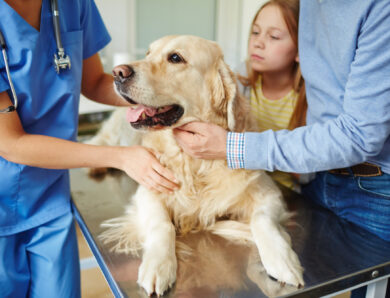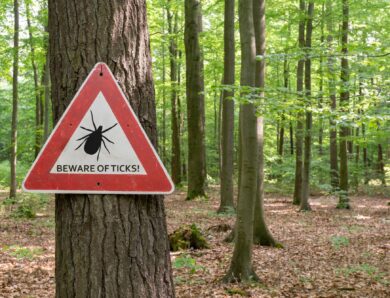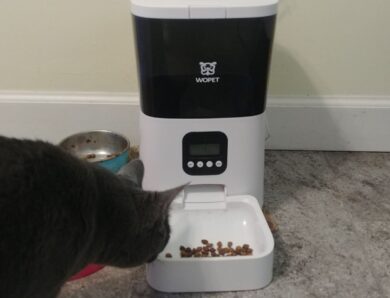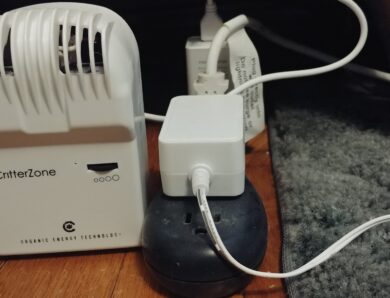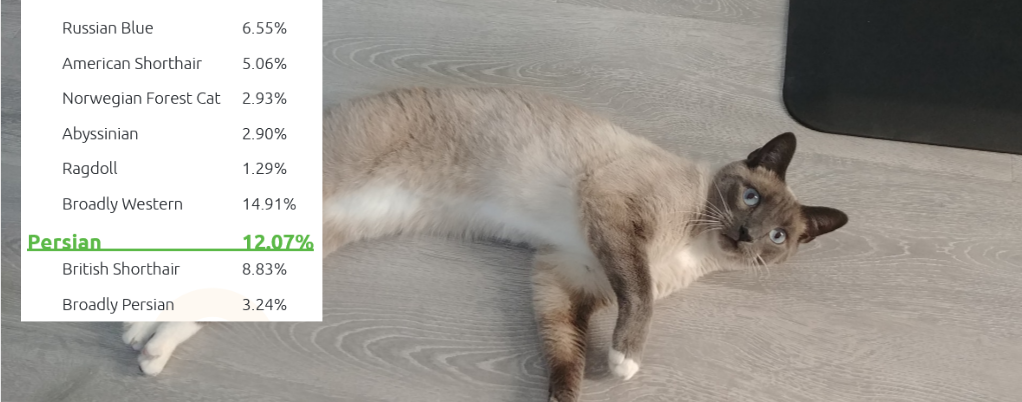
The Basepaws DNA Test: What You Need to Know – An In-Depth Review
The study of feline genetics is a relatively small field. Cat owners, historically, have been less interested in finding out about the history of their kitties, but that is changing. And Basepaws is at the forefront of this research.
But the results aren’t as straight forward as you may be hoping for.
Basepaws Breed + Health: What Is It
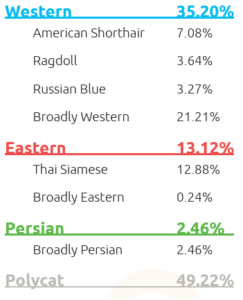
The Basepaws DNA test is the number one cat DNA kit on the market. It allows you to determine which breeds your cat shares genetic similarities with, but does not assign a breed.
The reason results do not — or rather cannot — assign a breed is simple.
Like dogs, the majority of cats are not pedigreed. But unlike dogs, most cats do not have a pedigreed ancestor. What the tests determine are the genetic similarities not the direct passing down of genetic ties.
Unless you have a purebred cat, you can expect a significant percentage of “polycat” to show up in the DNA results. Translation: your cat is a moggy. (aka mutt)
According to Basepaws, 93% of the worlds’ cats are “random-bred moggies.” Our cats were 30.98% (Ronaldo) and 49.22% (Noapte) polycat.
Breed Genetics vs Traits
“The relationship between your cat’s genetics (genotype) and the observable physical traits (phenotype) is extremely complicated,” says Damian Kao, COO of Basepaws.
What the DNA test does is look for genetic similarities between various phenotypes. Some breeds have traits that can be caused by a limited number of genotypes. Others, like Siamese, are genetically diverse, with traits (like point coloration) that can be caused by many different genotypes.
“There does not seem to be many points of genetic commonality among the modern Siamese cats we have collected,” Kao told Keeping It Pawsome. “This means that there are probably a lot of different genotypes that can result in traits typically associated with the modern Siamese cat.”
Kao added this is most likely because the breeding history of Siamese cats is long and is probably filled with many cross-breedings with other cat breeds.
13 Pictures of Cats in Boxes … Because Why Not!
Health Testing
The Basepaws kit also tests for inherited health issues, including diseases like Polycystic kidney disease, Retinal degeneration II, Autoimmune lymphoproliferative syndrome, Vitamin D-deficiency rickets (type I), along with many others you’ve probably never heard of.
Both of are cats tested negative for every disease included.
Basepaws: How We Used It
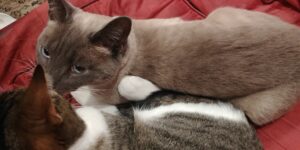
We chose to get two of our six cats tested, including one that looks remarkably like a Siamese. (Thus, our questions to Kao about Siamese cats in particular.)
Testing is simple.
Once you receive your kit, use the provided swab to collect saliva from your cat’s cheek. Seal the swab in the provided plastic bag and mail it back.
It takes several weeks to get results.
As a sidenote, as Basepaws collects more DNA from more cats around the world, it updates its database and refines its findings, so you should check back periodically to see if there’s new information on your kitty.
Basepaws: DNA Test Results in Short
Our results were surprising to say the least.
In a nutshell: we expected Ronaldo, our Siamese-looking cat, to share markers with cat breeds known for point coloration. He doesn’t. But Noapte, who is all black, does.
We expected Noapte, our 17-pound cat, to share markers with some of the largest cat breeds. He doesn’t, but Ronaldo, who is about 8 pounds, does.
Where we did find similarities between our cats and the breeds they share commonalities with are their personalities.
Keeping your cats stimulated is critical to their health. Learn how to stop boredom in cats.
DNA Test Results in Detail
Ronaldo (Siamese in appearance)
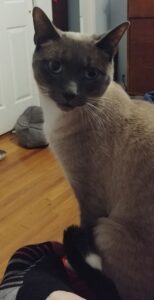
Ronaldo has zero markers for Siamese, Burmese, Birman, Himalayan, and Oriental Shorthair. (The test does show 3.2% “Broadly Persian” but then later lists him as 0% Persian.)
In other words, he shares no genetic breed markers (genotypes) for almost all the cat breeds best known for having point coloration.
He does share markers with the Norwegian Forest (2.9%) and Maine Coon (9.6%) breeds. Both of which can come in a variety of colors and patterns including point coloration.
Personality
Another way Ronaldo is similar to Maine Coons: They’re both vocal. He’s our most vocal cat (by far) and Maine Coons are known for being talkative.
Size
Unlike both Maine Coons and Norwegian Forest cats (both of which can reach up to 18 pounds), Ronaldo is on the small size, weighing about only 8 pounds.
He also shares genetic markers (5.1%) with the Savannah breed, one of the most exotic and largest breeds out there. Other than a short, dense coat, he shares no visible or personality traits with Savannahs (who can be up to 25 pounds in size).
Another surprising result for Ronaldo is that he shares genetic similarities with the Peterbald, an uncommon, exotic, hairless Eastern breed to which he bears no physical or personality similarities.
One last result worth sharing. Ronaldo shares markers with the Russian Blue breed (6.6%) and British Shorthair (8.8%). (Russian Blues are always blue gray in color, as are the vast majority of British Shorthairs.)
While he doesn’t in any way look or act like either breed, his sister is all Russian Blue/British Shorthair in appearance.
Interested in leash training your cat? Find out how.
Noapte (All black)
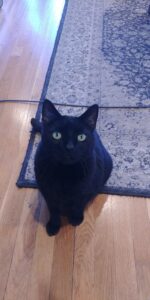
Noapte has a much simpler DNA breakdown, sharing markers with just five breeds (vs Ronaldo’s nine). But some of his results were also surprising.
Where we expected to find some level of similarity to the Siamese breed for Ronaldo, we expected none with Noapte.
His top result? Thai Siamese (12.88%) He also shares breed markers with Persians, though at a smaller level (2.46%).
Not only does he not at all resemble a Siamese, he also doesn’t share any of the Siamese personality beyond being one of our more intelligent cats.
Though the Thai Siamese (an Eastern breed) represents the largest single breed similarity, the bulk of his genetic markers fall into the category of Western breeds: American shorthair (7.08%), Russian Blue (3.27%) and Ragdoll (3.64%).
In appearance, he’s closest to an American Shorthair in all but coat and eye color. He’s large, sturdy, and has a large head and full cheeks. He has a short, dense coat, just like American Shorthairs, as well.
Personality
In temperament, he’s more similar to both Russian Blues and Ragdolls.
Similar to Russian Blues he’s curious, intelligent, loyal and can be sensitive to our emotions. And, like Ragdolls, he’s quite calm and easygoing (though he’s not a lap cat). Like both, he’s also fairly social and is always the first of our cats to greet visitors.
Size
He’s also our largest cat. In the past, he’s come close to 18 pounds. American Shorthairs, Russian Blues and Ragdolls generally only top the scales at 15 to 16 pounds.
We had expected him to share markers with some of the largest breeds including Norwegian Forest Cats and Maine Coons. He does not.
Basepaws DNA Test: Pros
It’s fun looking for the breed similarities, though we can’t help but wonder if we’d manage to find similarities between our cats and any breed.
It’s also interesting to see how genetically diverse and different from each other our cats are. As they were both rescued off our street several years apart, we always wondered if they might be related.
Based on their DNA results, they are not.
Basepaws DNA Test: Cons
While interesting, the results at this point in time are mostly meaningless.
Because most cats aren’t pedigreed and don’t have a pedigreed ancestor, they can’t be traced back to a breed. And the results can be a confusing mess of information that you’re not really sure how to interpret.
Basepaws DNA Test: Cost and Where You Can Buy It
Because Basepaws isn’t really an exact breed DNA system and the results are more interesting than truly informative, we’re not convinced the kit is worth the price. We highly recommend purchasing your DNA kit when it’s on sale. (We got ours during a sale that reduced the price to about $99 for each kit.)
With that said, we’ll most likely purchase another one or two to test more of our cats the next time there’s a good sale.
The Breed + Health DNA test normally sells for $149. A Whole Genome Sequencing kit, which claims to offer even more information about your cat, sells for $599. The company is also introducing a Dental CatKit, which will be offering insights into your kitty’s dental health. Pricing for the new kit, which comes out later this spring, hasn’t been released yet.
